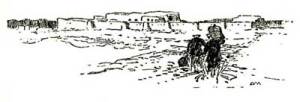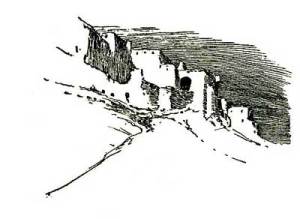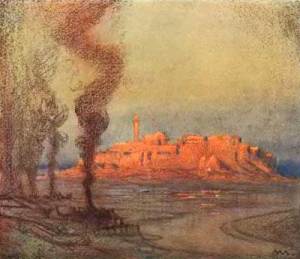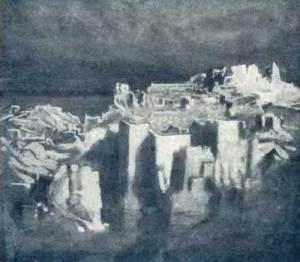[LOCATIONS] Some of the City-States, Settlements and Ruins of Sumer and Akkad
Ur: (pop. c. 15,000) here dwells Nanna-Sin in his shrine E-kishnugal; ruled by the undying ensi Shulgi, who seeks by recording all things to become a god. Bureaucracy pervades everything in the city (and fuels the resultant flourishing black markets); all transactions, all goings out and comings in, are recorded and archived. In Ur the Assembly of Old Men are shuffling priest-accountants; the Assembly of Young Men content themselves with games, absorbed in courtiers’ intrigues and atimes agitating for more expansionist policies and the final destruction of old enemies, Uruk, Larsa, Assur, Bab-Ilani. From the great gipar or cloister the royal princess Ennirziana, En-Priestess of Nanna, meddles in the dynastic policies of the city-states of Sumer and Akkad, using both her ritual authority and a vast network of spies, assassins and nuns. Mooring at the Radiant Quay and the Quay of Life, Ur’s boats ply both the Lower Sea and the myriad watercourses of the Land. Much of the city now extends over the forgotten buried riches of earlier Royal Tombs, interlinked chambers housing dead dynasts, their treasure and their murdered servants. Widow Geshtinana’s rambling, multichambered Alehouse, called the E-bursigsig, “House of Beautiful Bowls”, is a place of refreshment, worldly delights, rumour-mongering and the hatching of adventurous plots.
Eridu: (pop. c. 8,000) Home of Enki himself, his temple the E-engura, and the Abzu, Subterranean Lake of Sweet Waters (source of wizardries; the remnants of a dead god; the entrance to the Underworld). A crumbling city. Eridu lay once next to the Gulf of the Lower Sea, a great port, but after the paroxysms of the Deluge languishes inland, its pitch-caulked hulks grounded on the mud of its hollow harbours. Mere canals now serve Eridu’s Quay of the Crescent Moon. But sages still seek its libraries and archives extending to before the Deluge, and entry into secretive sorcerous and priestly societies; adventurers attempt lucrative consultations with the Abgal sage, or exchange strange ingredients for news of forgotten treasures.
 Ubeyid (pop. c. 5000) is a wretched temple-town sequestered in the lower marshlands of Sumer. Surrounding the temple complex on its higher mound are mudbrick shacks tenanted by herders of kine and harvesters of reeds and grain so wretchedly poor they shear their crops with sickles of clay. Further shacks are built of reed bundles plastered with mud where peasants squat and moan their dirges, weaving reed baskets and matting; the marshy hinterland controlled by Ubeyid contains a shifting population of floating reed islands of fishermen and pastoralists, and all bring fish-offering to the temple in Ubeyid. This temple town is ruled in secret by shapeshifting lizard-headed overlords, the Ophidians. These reptilians came from far stars or the void between them, and are now stranded, or have forgotten their way home, or unfathomably linger. Once (before the Flood) their empire stretched to the far north, and they meddled freely in the genetic makeup of the men and things they found around them; but Ubeyid is their last enclave, where they remain in the temple-palace complex demanding sacrifices and calling
Ubeyid (pop. c. 5000) is a wretched temple-town sequestered in the lower marshlands of Sumer. Surrounding the temple complex on its higher mound are mudbrick shacks tenanted by herders of kine and harvesters of reeds and grain so wretchedly poor they shear their crops with sickles of clay. Further shacks are built of reed bundles plastered with mud where peasants squat and moan their dirges, weaving reed baskets and matting; the marshy hinterland controlled by Ubeyid contains a shifting population of floating reed islands of fishermen and pastoralists, and all bring fish-offering to the temple in Ubeyid. This temple town is ruled in secret by shapeshifting lizard-headed overlords, the Ophidians. These reptilians came from far stars or the void between them, and are now stranded, or have forgotten their way home, or unfathomably linger. Once (before the Flood) their empire stretched to the far north, and they meddled freely in the genetic makeup of the men and things they found around them; but Ubeyid is their last enclave, where they remain in the temple-palace complex demanding sacrifices and calling  themselves Anunnaki. The temple complex is served by grey-clad shuffling priests, emaciated and with strange elongated heads (results of childhood cranial modification and head-wrapping) – on some moonless nights they go sniffling through Ubeyid removing newborns for induction into their order. The shrouded temple cult-statue is an ophidian figurine; the peregrinations of the cult-statue from Ubeyid are always at night (and never to Eridu) and sometimes it is an emaciated barely moving Ophidian itself that sits in the palanquin, gesturing feebly but enough to awe the people at the near presence of their terrible gods. The temple’s lower labyrinthine halls are of damp brick, in patches haphazardly glazed with sickly greens, patrolled by the long-headed priests, disfigured lizardmen, weird eels and frogemoths. Lowest are the inner chambers of the Ophidians, walls green-grey plastic clad, and chambers both swampily humid and coldly functional. A dispirited underground cult of Enki attempts some resistance to the priests, while in his hypostyle hall the chief of Ubeyid’s main tribe, the Beni Samak, dreams futilely of bloody insurrection.
themselves Anunnaki. The temple complex is served by grey-clad shuffling priests, emaciated and with strange elongated heads (results of childhood cranial modification and head-wrapping) – on some moonless nights they go sniffling through Ubeyid removing newborns for induction into their order. The shrouded temple cult-statue is an ophidian figurine; the peregrinations of the cult-statue from Ubeyid are always at night (and never to Eridu) and sometimes it is an emaciated barely moving Ophidian itself that sits in the palanquin, gesturing feebly but enough to awe the people at the near presence of their terrible gods. The temple’s lower labyrinthine halls are of damp brick, in patches haphazardly glazed with sickly greens, patrolled by the long-headed priests, disfigured lizardmen, weird eels and frogemoths. Lowest are the inner chambers of the Ophidians, walls green-grey plastic clad, and chambers both swampily humid and coldly functional. A dispirited underground cult of Enki attempts some resistance to the priests, while in his hypostyle hall the chief of Ubeyid’s main tribe, the Beni Samak, dreams futilely of bloody insurrection.
Badtabira: lost, ruined, of evil rumour, an Antediluvian city once great, recorded in the King Lists as exercising hegemony over all Sumer and Akkad, now a waste of heaps, ghoul-haunted, stirge-infested, clouded in flies. Within the overthrown city walls lies the pitchy slumped mound of Badtabira’s black ziggurat. Recrudescent cults of Dumuzi, it is said, seek his shrine and treasure here; agents of the Ophidians slink about intent on incomprehensible missions, while a few tomb-robbers and treasure-hunters comb the heaps and subterranean chambers in search of Antediluvian relics and the grave-goods of the perished.
Lagash (pop. c. 8,000): The estates of the god Ningirsu on the eastern fringes of Sumer; lately abandoned or disfavoured by the god, Lagash is infested by usurping Amurru nomads under Shagarakti-Shuriash their chief.
Girsu (pop. c. 5,500): twin city to Lagash and since the Deluge a part of the same state; now the rebel refuge of Lagash’s dynasts-in-exile, beseeching Enlil to restore their kingship; a hive of mercenaries.
Nigin (pop c. 3000): a cult centre of the goddess Nanshe, the Lady of Sirara, near Girsu and Lagash. Nanshe is an interpreter of dreams, and here in hostelries, ale-houses, lightless dens and temple dormitories pilgrims linger in hopes of oracular dreams or enlightenment as to their meaning, seeking the occluded will of the gods in the visions of sleep or in stupors enhanced by the hallucinogenic fumes of desert lotus distillates. Priestesses of Nanshe, lukkur priestesses, prostitutes, con-men, alewives, assassins, ecstatic visionaries, mercenaries, peddlers and priest-kings, beggars and thieves all mingle in Nigin.
 Larsa (pop. c. 10,000) demesne of Utu-Shamash, the solar god of justice and travel; to his temples and courts disputes are brought. In a certain temple with certain prayers and sacrifices it is said the aggrieved may move the hand of the Saw of Shamash: a fraternity of assassins who claim some sort of priesthood of retribution of the god. Warad-Sin is the ensi of Larsa.
Larsa (pop. c. 10,000) demesne of Utu-Shamash, the solar god of justice and travel; to his temples and courts disputes are brought. In a certain temple with certain prayers and sacrifices it is said the aggrieved may move the hand of the Saw of Shamash: a fraternity of assassins who claim some sort of priesthood of retribution of the god. Warad-Sin is the ensi of Larsa.
Uruk (pop. c. 12,000): one-third gardens, one-third houses, and one-third temples, they say of Uruk-the-Sheepfold, Inanna’s own city. If Gilgamesh raised her walls, and Enmerkar once brought tribute and treasures out of Aratta, Uruk now broods over her imperial past. Two sacred precincts lie at its heart: the massive Eanna temple complex honours Inanna, while Kulluba contains Anu’s ziggurat and his White Temple. But in Uruk too are the myriad shrines of a thousand foreign gods brought back by Uruk colonists and traders in past days. Its ensi, Mesh-he the metal-worker, is rumoured to be a sorcerer. In Uruk is the E-mush, House which is a precinct, a guild-house of the rangers of Uruk.
Nippur (pop. c. 8,000) site of the E-kur, the Mountain House that is Enlil’s shrine; Enlil grants the kingship and any aspirant hegemon of Sumer and Akkad makes obeisance and offering at this temple.
Agade: “Inanna be praised for the destruction of Agade!” runs the Curse of Agade; this city of great Sargon and divine Naram-Sin – who once and for the first time brought all Sumer and Akkad under their net, who ruled the Land and all Subartu from Lower Sea to Middle Sea as their Empire – is a mound of ruins prowled by ‘alert snakes,’ its very location, and the nature of the treasures it may house, now a matter of rumour and speculation.
Bab-Ilani (pop. c 120,000), the Great, the Gate of God: what city is like unto this great city? Clothed in fine linen and purple and scarlet and decked with stone and precious metal and pearls! Her slave-markets most eclectic; her spice markets most choice; her ziggurats most lofty, temples clad in lapis lazuli and alabaster where fragrant incense ceaselessly rises! The noble houses of Bab-Ilani vie in the lavishness of their feasts and in their intimate courts entertain strange counsellors, while astrologers, diviners and wizards ever refine the acuity of their speculations. The Hanging Gardens, a past lugal’s gift to a foreign wife, is a fevered dream made manifest, containing strange flora and weird beasts, and is an occasional amphitheatre for hunts of slaves or enemies of the king’s household.
Merodach-Baladan is called lugal in Bab-Ilani, King of Kings, King of the Four Quarters, King of Kish; but most power is exercised on his behalf by the Sage of the Assembly, for the king angered some god and as a result paws the palace-garden grounds in a state of bestial imbecility. Court wizard-priests have since developed a novel system of divination by which they calibrate the pitch of his howling whines to the putative will of the gods.
Kish (pop. c. 2500) is a dream-soaked village huddled in the remains of past glory. A cadre of scholarly priests maintains The King List and the temple in which any hegemon of Sumer and Akkad must have the lugal Kish, the Kingship of Kish, conferred by the god. Beyond the few scattered huts and temple complex lie the mouldering mounds of the greater city, including the tombs of the Great Lugals of Kish’s past. Kug-Bau the Alewife is the ruler of Kish.
Kutha (pop. c. 7,000): Nergal’s own terrible estate, site of the E-Mesalem, his shrine, an open maw to Erkalla, the Great City, the Land of No Return, Kurnugi, the Underworld where Ereshkigal wails. A haunt of necromancer-priests and mercenaries without hope.
 The Muriq-Tidnim (“Fender off of Tidnum”), a great Wall raised by Amar-Sin of Ur against the threat of marauding Martu nomads. The Wall, now collapsed along great stretches, runs north of Sippar from the Euphrates across the fringes of the alluvial plain to the banks of the Tigris; scattered settlements are huddled in its shadow, and along it are dotted fortresses, bastions and caravanserai abandoned or the refuge of bandits.
The Muriq-Tidnim (“Fender off of Tidnum”), a great Wall raised by Amar-Sin of Ur against the threat of marauding Martu nomads. The Wall, now collapsed along great stretches, runs north of Sippar from the Euphrates across the fringes of the alluvial plain to the banks of the Tigris; scattered settlements are huddled in its shadow, and along it are dotted fortresses, bastions and caravanserai abandoned or the refuge of bandits.
Igi-hursaga, a rambling, concentric fortress constructed by Ur-Nammu in defense of the cities of the plain against Amurru tribes, now the chaotic seat of Kara-hardash a bandit-warlord and his bands of mercenary nomads, Elamite assassins, and bestial Gutian henchcreatures.


